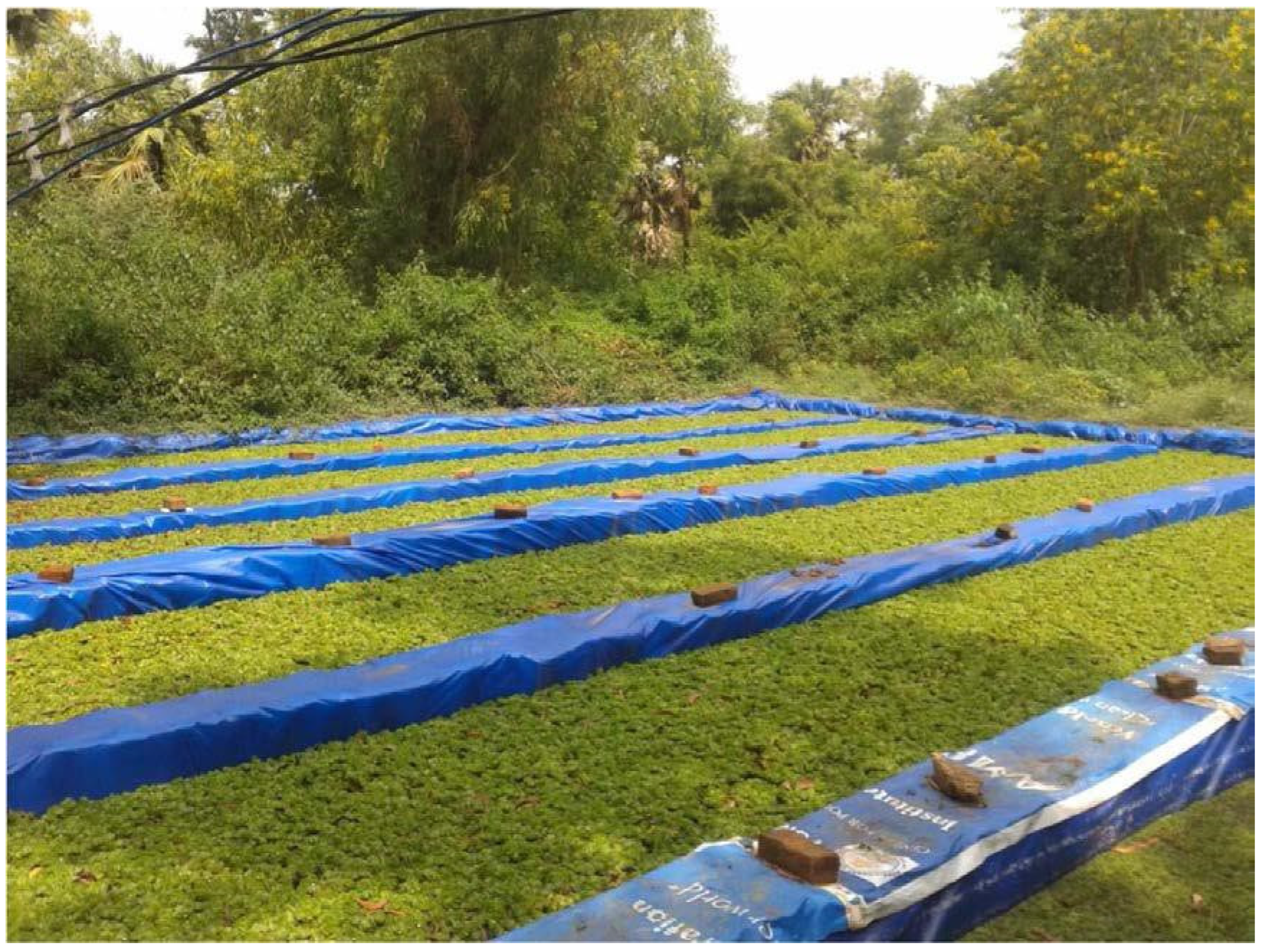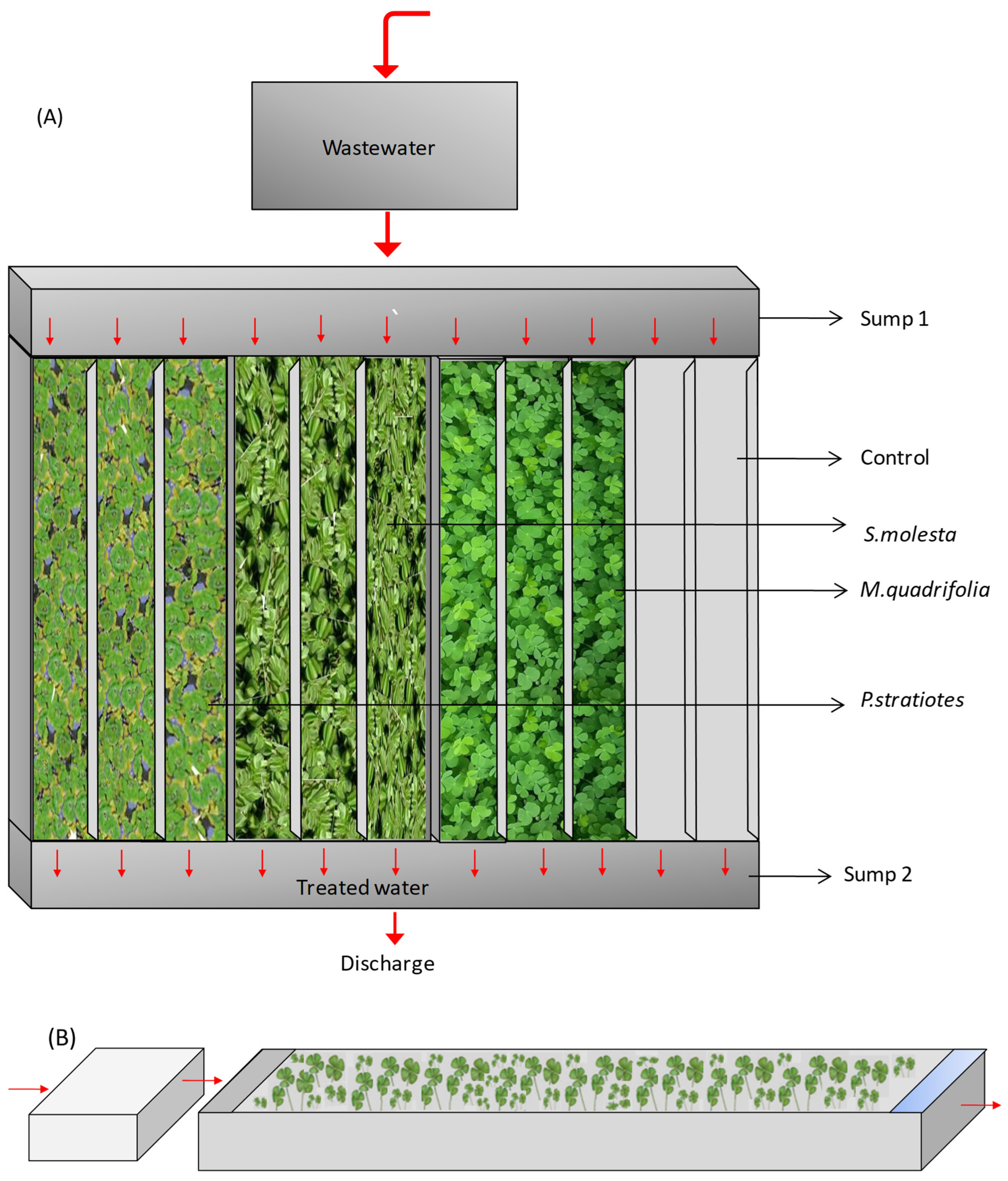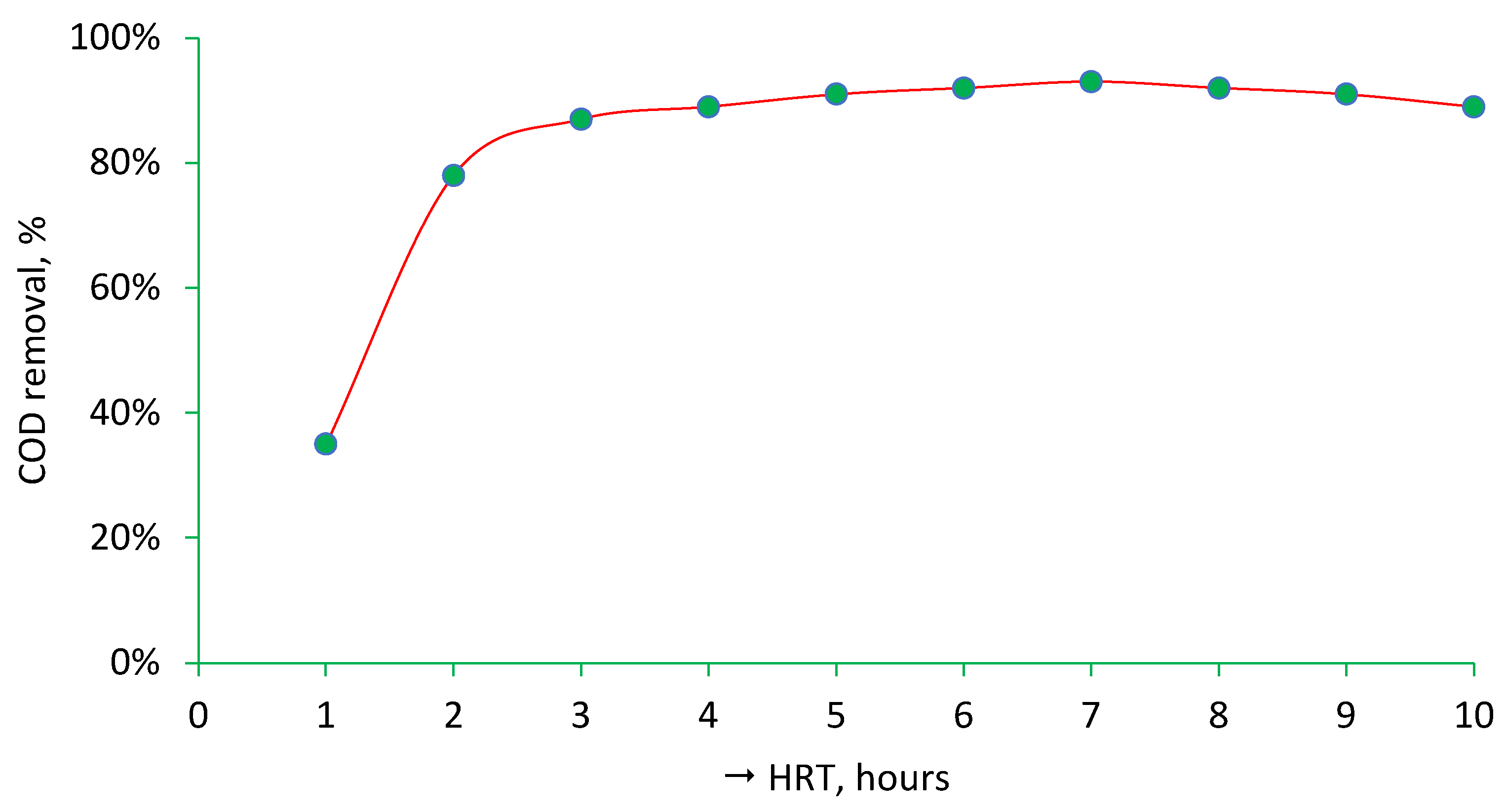Process Design and Assessment of the Performance of Three Macrophytes in a Biorefinery Polishing Partly Treated Sewage in Novel SHEFROL Bioreactors
Abstract
:1. Introduction
1.1. Surprising Inadequacy of Information on the Use of Macrophytes in Biorefineries
1.2. The Virtues of Macrophytes in the Biorefinery Context
1.3. Emerging Role of the SHEFROL Technology
1.4. The Present Work
2. Materials and Method
2.1. Approach to Process Design
2.2. Reactor Fabrication and Process Monitoring
2.3. Sampling and Analysis
2.4. Use of COD as an Indicator Parameter and Analytical Quality Control
2.5. Statistical Analysis
3. Results and Discussion
3.1. Polishing of Sewage Achieved by the Three Macrophytes
3.2. Mechanism of Pollutant Removal
4. Generation of Energy Precursors and Organic Fertilisers from the Harvested Macrophytes to Close the Biorefinery Loop
5. Summary and Conclusions
Author Contributions
Funding
Institutional Review Board Statement
Data Availability Statement
Acknowledgments
Conflicts of Interest
References
- Chang, J.-S.; Mohan, S.V.; Sim, S.J.; Lee, D.-J.; Barbosa, M. Recent advances in algal biorefinery. Bioresour. Technol. 2022, 347, 126734. [Google Scholar] [CrossRef] [PubMed]
- Sharma, P.; Gujjala, L.K.S.; Varjani, S.; Kumar, S. Emerging microalgae-based technologies in biorefinery and risk assessment issues: Bioeconomy for sustainable development. Sci. Total Environ. 2022, 813, 152417. [Google Scholar] [CrossRef]
- Talebi, S.; Edalatpour, A.; Tavakoli, O. Algal biorefinery: A potential solution to the food–energy–water–environment nexus. Sustain. Energy Fuels 2022, 6, 2623–2664. [Google Scholar] [CrossRef]
- Tuyen, N.V.; Limjuco, L.A.; Lee, K.; Dang, N.M. Integrated Applications of Microalgae to Wastewater Treatment and Biorefinery: Recent Advances and Opportunities. Appl. Chem. Eng. 2022, 33, 242–257. [Google Scholar] [CrossRef]
- Ummalyma, S.B.; Sirohi, R.; Udayan, A.; Yadav, P.; Raj, A.; Sim, S.J.; Pandey, A. Sustainable microalgal biomass production in food industry wastewater for low-cost biorefinery products: A review. Phytochem. Rev. 2022, 1–23. (In Press) [Google Scholar] [CrossRef] [PubMed]
- Robles-Pliego, M.; Olguín, E.J.; Hernández-Landa, J.; González-Portela, R.E.; Sánchez-Galván, G.; Cuervo-López, F. Dual purpose system for water treatment from a polluted river and the production of pistia stratiotes biomass within a biorefinery. Clean-Soil Air Water 2015, 43, 1514–1521. [Google Scholar] [CrossRef]
- Olguín, E.J.; García-López, D.A.; González-Portela, R.E.; Sánchez-Galván, G. Year-round phytofiltration lagoon assessment using Pistia stratiotes within a pilot-plant scale biorefinery. Sci. Total Environ. 2017, 592, 326–333. [Google Scholar] [CrossRef]
- Calicioglu, O.; Richard, T.L.; Brennan, R.A. Anaerobic bioprocessing of wastewater-derived duckweed: Maximizing product yields in a biorefinery value cascade. Bioresour. Technol. 2019, 289, 121716. [Google Scholar] [CrossRef]
- Calicioglu, O.; Femeena, P.V.; Mutel, C.L.; Sills, D.L.; Richard, T.L.; Brennan, R.A. Techno-economic analysis and life cycle assessment of an integrated wastewater-derived duckweed biorefinery. ACS Sustain. Chem. Eng. 2021, 9, 9395–9408. [Google Scholar] [CrossRef]
- Vymazal, J. Plants used in constructed wetlands with horizontal subsurface flow: A review. Hydrobiologia 2011, 674, 133–156. [Google Scholar] [CrossRef]
- Sahtouris, E. Beautiful Bulrushes, Remarkable Reeds: The Water Reclamation Miracles of Kaethe Seidel. LifeWeb 1990. Available online: https://ratical.org/LifeWeb/Articles/rushes.html (accessed on 7 November 2022).
- Crites, R.; Middlebrooks, J.; Reed, S. Natural Wastewater Treatment System; CRC Press: Boca Raton, FL, USA, 2006; pp. 1–552. [Google Scholar]
- Abbasi, T.; Abbasi, S.A. Production of clean energy by anaerobic digestion of phytomass—New prospects for a global warming amelioration technology. Renew. Sustain. Energy 2010, 14, 1653–1659. [Google Scholar] [CrossRef]
- Abbasi, T.; Abbasi, S.A. Factors which facilitate waste water treatment in presence of aquatic weeds—The mechanism of the weed’s purifying action. Int. J. Environ.Stud. 2010, 67, 349–371. [Google Scholar] [CrossRef]
- Abbasi, S.A.; Khan, F.I.; Abbasi, N. Design of aquatic macrophyte based wastewater treatment systems. J. Inst. Eng. (India) Env. Eng. Div. 2001, 82, 7–16. [Google Scholar]
- Smith, W.H.; Reddy, K.R. Aquatic Macrophytes for Water Treatment and Resource Recovery; Magnolia Publishing: Orlando, FL, USA, 1987; ISBN 09-414-63001. [Google Scholar]
- Abbasi, S.A.; Nipaney, P.C. Environmental impact of retting of coconut husk and directions for the development of alternative retting technology. Pollut. Res. 1993, 12, 117–118. [Google Scholar]
- Abbasi, S.A.; Nipaney, P.C. Productivity of aquatic weed Salvinia (Salvinia molesta, Mitchell) in natural waters. Ecol. Env. Conserv. 1995, 1, 11–12. [Google Scholar]
- Abbasi, S.A.; Tabassum-Abbasi Ponni, G.; Tauseef, S.M. Potential of joyweed alternanthera sessilis for rapid treatment of domestic sewage in SHEFROL® bioreactor. Int. J. Phytorem. 2019, 21, 160–169. [Google Scholar] [CrossRef]
- Tabassum-Abbasi; Patnaik, P.; Tauseef, S.M.; Abbasi, S.A. SHEFROL® bioreactor enhances the ability of pistia (Pistia stratiotes) in the phytoremediation of greywater. Int. J. Environ. Anal. Chem. 2022, 102, 1502–1511. [Google Scholar] [CrossRef]
- Wei, B.; He, W.; Limei, T.; Jie, Z.; Huichao, J.; Wenbo, D.; Luquan, R. Small structure, large effect: Functional surfaces inspired by salvinia leaves. Small Struct. 2021, 2, 2100079. [Google Scholar] [CrossRef]
- Abbasi, S.A.; Tabassum-Abbasi; Patnaik, P. Biomimetically generated nanoparticles in boosting the performance of microbial fuel cells. Nat. Environ. Pollut. Technol. 2021, 20, 1881–1886. [Google Scholar] [CrossRef]
- Tabassum-Abbasi; Abbasi, T.; Abbasi, S.A. Microbial Fuel Cells as Source of Clean Energy—Potential and Pitfalls. Nat. Environ. Pollut. Technol. 2019, 18, 789–797. [Google Scholar]
- Bhat, M.A.; Abbasi, T.; Abbasi, S.A. An inexpensive phytoremediation system for treating 50,000 L/day of sewage. Int. J. Phytorem. in press. 2022. [Google Scholar] [CrossRef] [PubMed]
- Abbasi, S.A.; Ponni, G.; Tauseef, S.M. Marsilea quadrifolia: A new bioagent for treating wastewater. Water Air Soil Pollut. 2018, 229, 1–8. [Google Scholar] [CrossRef]
- Abbasi, S.A. SHEFROL Trademark number 4735305, granted by Intellectual Property India. 4 May 2021. [Google Scholar]
- Bhat, M.A.; Abbasi, T.; Abbasi, S.A. A household-scale on-site embodiment of the novel bioreactor SHEFROL® for treating greywater. Taiwan Water Conserv. 2020, 68, 26–35. [Google Scholar] [CrossRef]
- Bhat, M.A.; Abbasi, T.; Abbasi, S.A. A pilot plant of SHEFROL phytoremediation Technology for treating greywater of a typical Indian village. Int. J. Environ.Pollut. 2021, 41, 668–672. [Google Scholar]
- Abbasi, S.A.; Tauseef, S.M. A system for rapid and inexpensive treatment of sewage using the weed false daisy (Eclipta prostrata). Water Environ. J. 2018, 32, 573–584. [Google Scholar] [CrossRef]
- Abbasi, S.A.; Tauseef, S.M. Use of the terrestrial weed Alternanthera ficoidea in treating greywater in soil-less SHEFROL® bioreactors. Water Sci. Technol. 2018, 77, 2005–2013. [Google Scholar] [CrossRef]
- USEPA. Code of Practice—Domestic Wastewater Treatment Systems; United States Environmental Protection Agency: Washington, DC, USA, 2021; Available online: https://www.epa.ie/publications/compliance--enforcement/waste-water/2021CodeofPracticeWeb.
- World Health Organization. The World Health Report: 2006: Working Together for Health; World Health Organization: Geneva, Switzerland, 2006. [Google Scholar]
- CPCB—Central Pollution Control Board, India. General Standards for the Discharge of Environmental Pollutants in Inland Surface Water, Public Sewers, Land for Irrigation. 2022. Available online: https://www.cpcb.nic.in (accessed on 7 November 2022).
- Eaton, A.D.; Clesceri, L.S.; Franson, M.A.H.; Rice, E.W.; Greenberg, A.E. Standard Methods for the Examination of Water & Wastewater; American Public Health Association; American Water Works Association: New York, NY, USA, 2005; ISBN 0875530478, 9780875530475. [Google Scholar]
- Abbasi, S.A. Water Quality—Sampling and Analysis; Discovery Publishing House: New Delhi, India, 1998; pp. viii+212. [Google Scholar]
- Abbasi, T.; Abbasi, S.A. Perspectives in Pollution Control and Sustainable Development; Discovery Publishing House: New Delhi, India, 2018; pp. xi+510. [Google Scholar]
- Alan, C.G.; David, S.H. Practical Statistics and Experimental Design for Plant and Crop Sciences; Wiley: Oxford, UK, 2001; pp. 346. [Google Scholar]
- Li, Q.G.; Long, Z.Q.; Wang, H.J.; Zhang, G.M. Functions of constructed wetland animals in water environment protection—A critical review. Sci. Total Environ. 2021, 760, 144038. [Google Scholar] [CrossRef]
- Kuzyakov, Y.; Razavi, B.S. Rhizosphere size and shape: Temporal dynamics and spatial stationarity. Soil Biol. Biochem. 2019, 135, 343–360. [Google Scholar] [CrossRef]
- Rampuria, A.; Kulshreshtha, N.M.; Gupta, A.; Brighu, U. Novel microbial nitrogen transformation processes in constructed wetlands treating municipal sewage: A mini-review. World J. Microbiol. Biotechnol. 2021, 37, 1–11. [Google Scholar] [CrossRef]
- Abbasi, T.; Tauseef, S.M.; Abbasi, S.A. Anaerobic digestion for global warming control and energy generation: An overview. Renew. Sustain. Energy Rev. 2012, 16, 3228–3242. [Google Scholar] [CrossRef]
- Ahmed, S.F.; Rafa, N.; Mofijur, M.; Badruddin, I.A.; Inayat, A.; Ali, M.S.; Farrok, O.; Khan, T.M.Y. Biohydrogen production from biomass sources: Metabolic pathways and economic analysis. Front. Energy Res. Sec. Bioenergy Biofuels 2021, 9, 753878. [Google Scholar] [CrossRef]
- Kumar, M.R.; Tauseef, S.M.; Abbasi, T.; Abbasi, S.A. Control of amphibious weed ipomoea (ipomoea carnea) by utilizing it for the extraction of volatile fatty acids as energy precursors. J. Adv. Res. 2015, 6, 73–78. [Google Scholar] [CrossRef] [PubMed] [Green Version]
- Kumar, M.R.; Tauseef, S.M.; Abbasi, T.; Abbasi, S.A. Conversion of Volatile Fatty Acids (VFAs) Obtained from Ipomoea (Ipomoea carnea) to Energy. In Advances in Health and Environment Safety; Siddiqui, N.A., Tauseef, S.M., Kansal, B., Eds.; Springer Transactions in Civil and Environmental Engineering: Berlin, Germany, 2018; Chapter 28; pp. 269–278. [Google Scholar] [CrossRef]
- Abbasi, S.A.; Nayeem-Shah, M.; Abbasi, T. Vermicomposting of phytomass: Limitations of the past approaches and the emerging directions. J. Cleaner Prod. 2015, 93, 103–114. [Google Scholar] [CrossRef]
- Tauseef, S.M.; Abbasi, T.; Patnaik, P.; Abbasi, S.A. A novel high-rate vermicomposting machine for downstream processing of biorefinery waste and other forms of organic solid waste. Biomass Convers. Biorefin. 2021, 1–10. (In Press) [Google Scholar] [CrossRef]
- Ganeshkumar, T.; Premalatha, M.; Gajalakshmi, S.; Abbasi, S.A. A new process for the rapid and direct vermicomposting of the aquatic weed salvinia (Salvinia molesta). Bioresour. Bioprocess. 2014, 1, 1–5. [Google Scholar] [CrossRef] [Green Version]
- Nayeem-Shah, M.; Gajalakshmi, S.; Abbasi, S.A. Direct, rapid and sustainable vermicomposting of the leaf litter of neem (Azadirachta indica). Appl. Biochem.Biotechnol. 2015, 2, 792–801. [Google Scholar] [CrossRef]
- Hussain, N.; Abbasi, T.; Abbasi, S.A. Vermicomposting eliminates the toxicity of lantana (Lantana camara) and turns it into a plant friendly organic fertilizer. J. Hazard.Mater. 2015, 298, 46–57. [Google Scholar] [CrossRef]
- Hussain, N.; Abbasi, T.; Abbasi, S.A. Vermiremediation of an invasive and pernicious weed salvinia (Salvinia molesta). Ecol. Eng. 2016, 91, 432–440. [Google Scholar] [CrossRef]
- Hussain, N.; Abbasi, T.; Abbasi, S.A. Vermicomposting transforms allelopathic parthenium into a benign organic fertilizer. J. Environ. Manage. 2016, 180, 180–189. [Google Scholar] [CrossRef]
- Hussain, N.; Abbasi, T.; Abbasi, S.A. Toxic and allelopathic ipomoea yields plant friendly organic fertilizer. J. Cleaner Prod. 2017, 148, 826–835. [Google Scholar] [CrossRef]
- Patnaik, P.; Abbasi, T.; Abbasi, S.A. Vermicompost of the widespread and toxic xerophyte prosopis (Prosopis juliflora) is a benign organic fertilizer. J. Hazard.Mater. 2020, 399, 122864. [Google Scholar] [CrossRef] [PubMed]
- Hussain, N.; Abbasi, S.A. Efficacy of the vermicomposts of different organic wastes as “clean” fertilizers: State-of-the-art. Sustainability 2018, 10, 1205. [Google Scholar] [CrossRef] [Green Version]
- Hussain, N.; Abbasi, T.; Abbasi, S.A. Generation of highly potent organic fertilizer from pernicious aquatic weed Salvinia molesta. Environ. Sci. Pollut. Res. 2018, 25, 4989–5002. [Google Scholar] [CrossRef] [PubMed]
- Hussain, N.; Abbasi, T.; Abbasi, S.A. Evaluating the fertilizer and pesticidal value of vermicompost generated from a toxic and allelopathic weed ipomoea. J. Saudi Soc. Agric.Sci. 2020, 19, 43–50. [Google Scholar] [CrossRef]
- Dhanuja, C. Greenhouse gas emissions from paddy fields with special reference to the effect of vemricomposts and synthetic chemical fertilizers. Ph.D. Thesis, Pondicherry University, Puducherry, India, 2019; pp. xiii+249. [Google Scholar]




| Parameter | Standards for Discharge | |||
|---|---|---|---|---|
| On Inland Surface Waters | In Public Sewers | On Land for Irrigation | In Marine Coastal Areas | |
| SS, mg/L | ≤100 | ≤600 | ≤200 | ≤100 |
| pH | 5.5–9.0 | 5.5–9.0 | 5.5–9.0 | 5.5–9.0 |
| TKN, mg/L | ≤100 | -- | -- | ≤100 |
| BOD, mg/L | ≤30 | ≤350 | ≤100 | ≤100 |
| COD, mg/L | ≤250 | -- | -- | ≤250 |
| Cu, mg/L | ≤3.0 | ≤3.0 | -- | ≤3.0 |
| Zn, mg/L | ≤5.0 | ≤15 | -- | ≤15 |
| Ni, mg/L | ≤3.0 | ≤3.0 | -- | ≤5.0 |
| Mn, mg/L | ≤2.0 | ≤2.0 | -- | ≤2.0 |
| Characteristic | Range, mg/L |
|---|---|
| BOD | 30–60 |
| COD | 55–90 |
| SS | 60–85 |
| TKN | 37–55 |
| SP | 2–4 |
| Zn | 2–6 |
| Cu | 1–4 |
| Ni | 2–4 |
| Mn | 1–2 |
| HRT, Hours | Average Steady State COD, %, Removal by | ||
|---|---|---|---|
| P. stratiotes | S. molesta | M. quadrifolia | |
| 1 | 34 ± 2 | 32 ± 2 | 35 ± 2 |
| 2 | 77 ± 3 | 76 ± 2 | 78 ± 2 |
| 3 | 85 ± 3 | 84 ± 3 | 87 ± 2 |
| 4 | 88 ± 2 | 86 ± 3 | 89 ± 2 |
| 5 | 89 ± 3 | 88 ± 3 | 91 ± 3 |
| 6 | 91 ± 3 | 90 ± 3 | 93 ± 2 |
| 7 | 92 ± 3 | 90 ± 2 | 93 ± 3 |
| 8 | 91 ± 3 | 89 ± 3 | 92 ± 3 |
| 9 | 90 ± 3 | 90 ± 3 | 91 ± 2 |
| 10 | 88 ± 2 | 87 ± 3 | 89 ± 3 |
| Constituent | Average Removal, %, by | Maximum Observed Concentration in the Effluent, mg/L | ||
|---|---|---|---|---|
| P. stratiotes | S. molesta | M. quadrifolia | ||
| BOD | 79 ± 3 | 77 ± 3 | 81 ± 3 | 15.6 |
| COD | 77 ± 3 | 76 ± 2 | 78 ± 3 | 23.4 |
| SS | 94 ± 3 | 92 ± 3 | 95 ± 3 | 9.4 |
| TKN | 59 ± 2 | 56 ± 2 | 61 ± 3 | 25.3 |
| SP | 60 ± 3 | 63 ± 2 | 66 ± 3 | 1.7 |
| Zn | 43 ± 4 | 43 ± 3 | 46 ± 3 | 3.7 |
| Cu | 46 ± 2 | 45 ± 2 | 48 ± 2 | 2.3 |
| Ni | 32 ± 3 | 30 ± 1 | 35 ± 2 | 2.8 |
| Mn | 31 ± 2 | 31 ± 2 | 33 ± 3 | 1.4 |
Publisher’s Note: MDPI stays neutral with regard to jurisdictional claims in published maps and institutional affiliations. |
© 2022 by the authors. Licensee MDPI, Basel, Switzerland. This article is an open access article distributed under the terms and conditions of the Creative Commons Attribution (CC BY) license (https://creativecommons.org/licenses/by/4.0/).
Share and Cite
-Abbasi, T.; Patnaik, P.; Abbasi, S.A. Process Design and Assessment of the Performance of Three Macrophytes in a Biorefinery Polishing Partly Treated Sewage in Novel SHEFROL Bioreactors. Processes 2022, 10, 2350. https://doi.org/10.3390/pr10112350
-Abbasi T, Patnaik P, Abbasi SA. Process Design and Assessment of the Performance of Three Macrophytes in a Biorefinery Polishing Partly Treated Sewage in Novel SHEFROL Bioreactors. Processes. 2022; 10(11):2350. https://doi.org/10.3390/pr10112350
Chicago/Turabian Style-Abbasi, Tabassum, Pratiksha Patnaik, and S. A. Abbasi. 2022. "Process Design and Assessment of the Performance of Three Macrophytes in a Biorefinery Polishing Partly Treated Sewage in Novel SHEFROL Bioreactors" Processes 10, no. 11: 2350. https://doi.org/10.3390/pr10112350
APA Style-Abbasi, T., Patnaik, P., & Abbasi, S. A. (2022). Process Design and Assessment of the Performance of Three Macrophytes in a Biorefinery Polishing Partly Treated Sewage in Novel SHEFROL Bioreactors. Processes, 10(11), 2350. https://doi.org/10.3390/pr10112350






